If you are in steel industry, have you ever notice what all those chemical composition listed on a steel materials test report really mean? You may only know different steel grade has many different chemical composition and elements in different amount. Here in this post, we sort out and list 21 chemical elements and effects on steel properties.
21 Chemical Elements and Effects on Steel Mechanical Properties
Steel in general is an alloy of carbon and iron, it does contain many other elements, some of which are retained from the steel making process, other elements are added to produce specific properties. We can see some most common chemical elements with important effects on steel properties.
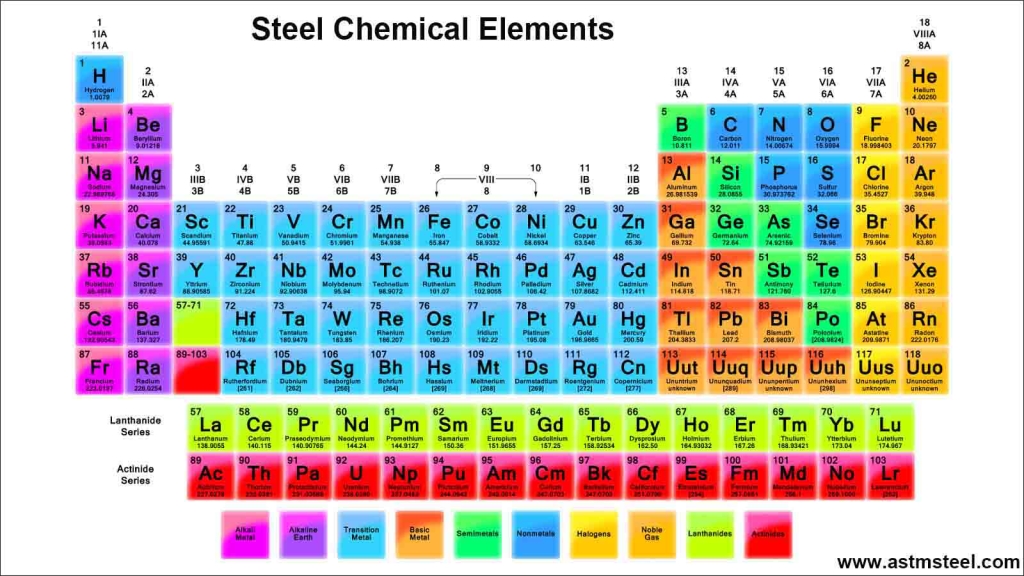
1. Carbon (C)
Carbon is the most important element in steel, it is essential in steels which have to be hardened by quenching and the degree of carbon controls the hardness and strength of the material, as well as response to heat treatment (hardenability).
And ductility, forgeability and machinability will decrease if the amount of carbon increases, as well as weldability properties of the steel.
2 .Manganese (Mn)
Manganese could be the second most important element after Carbon on steel. Mn has effects similar to those of carbon, and the steel producer uses these two elements in combination to obtain a material with the desired properties. Manganese is a necessity for the process of hot rolling of steel by its combination with oxygen and sulfur.
Its presence has below main effects:
- It is a mild deoxidant acting as a cleanser taking the sulphur and oxygen out of the melt into the slag.
- It increases the harden ability and tensile strength but decreases ductility.
- It combines with sulphur to form globular manganese sulphides, essential in free cutting steels for good machinability.
Steels usually contain at least 0.30% manganese, however, amounts of up to 1.5% can be found in some carbon steels.
Manganese also tends to increase the rate of carbon penetration during carburizing and acts as a mild deoxidizing agent. However when too high carbon and too high manganese accompany each other, embrittlement sets in. Manganese is capable to form Manganese Sulphide (MnS) with sulphur, which is beneficial to machining. At the same time, it counters the brittleness from sulphur and is beneficial to the surface finish of carbon steel.
For welding purposes, the ratio of manganese to sulphur should be at least 10 to 1. Manganese content of less than 0.30% may promote internal porosity and cracking in the weld bead, cracking can also result if the content is over 0.80%. Steel with low Manganese Sulphide ratio may contain sulphur in the form of iron Sulphide (FeS), which can cause cracking in the weld.
3. Phosphorus (P)
Although it increases the tensile strength of steel and improves machinability it is generally regarded as an undesirable impurity because of its embrittling effect.
Effect of phosphorus element will have various effects on steel depending on concentration.
The maximum amount of phosphorus in higher grade steel is between 0.03 to 0.05% due to the fact that is detrimental. Up to 0.10% of phosphorus in low-alloy high-strength steels will increase the strength as well as improve the steel’s resistance against corrosion. The possibility of brittlement increases when the content in hardened steel is too high. Even though the strength and hardness is improved, the ductility and toughness decreases.
The machinability is improved in free-cutting steel, but weld brittle and/or weld cracks can occur during welding if the phosphorus content is more than 0.04%. Phosphorus also affects the thickness of the zinc layer when galvanising steel.
4. Sulfur (S)
Sulfur is normally regarded as an impurity and has an adverse effect on impact properties when a steel is high in sulphur and low in manganese. Sulphur improves machinability but lowers transverse ductility and notched impact toughness and has little effects on the longitudinal mechanical properties. Its content is limited to 0.05% in steels but is added to free cutting steels in amount up to 0.35% with the manganese content increased to counter any detrimental effects since alloying additions of sulfur in amounts from 0.10% to 0.30% will tend to improve the machinability of a steel. Such types may be referred to as “resulfurized” or “freemachining”. Free cutting steels have sulphur added to improve machinability, usually up to a maximum of 0.35%.
Even though the effect of sulphur on steel is negative at certain stages, any sulphur content less than 0.05% has a positive effect on steel grades.
5. Silicon (Si)
Silicon is one of the principal deoxidizers for steel. Silicon helps to remove bubbles of oxygen from the molten steel. It is the element that is most commonly used to produce semi- and fully killed steels, and normally appears in amounts less than 0.40 percent, usually only small amounts (0.20%) are present in rolled steel when it is used as a deoxidizer. However, in steel castings, 0.35 to 1.00% is commonly present.
Silicon dissolves in iron and tends to strengthen it. Some filler metals may contain up to 1% to provide enhanced cleaning and deoxidation for welding on contaminated surfaces. When these filler metals are used for welding on clean surfaces, the resulting weld metal strength will be markedly increased. Silicon increases strength and hardness but to a lesser extent than manganese. The resulting decrease in ductility could resent cracking problems.
For galvanizing purposes, steels containing more than 0.04% silicon can greatly affect the thickness and appearance of the galvanized coating. This will result in thick coatings consisting mainly zinc-iron alloys and the surface has a dark and dull finish. But it provides as much corrosion protection as a shiny galvanized coating where the outer layer is pure zinc.
6. Chromium (Cr)
Chromium is a powerful alloying element in steel. Cr presents in certain structural steels in small amounts. It is primarily used to increase hardenability of steel and increase the corrosion resistance as well as the yield strength of the steel material. For that reason often occurs in combination with nickel and copper. Stainless steels may contain in excess of 12% chromium. The well-known “18-8” stainless steel contains 8 percent of nickel and 18 percent of chromium.
When the percent of chromium in the steel exceeds 1.1% a surface layer is formed that helps protect the steel against oxidation.
7. Vanadium (V)
The effects of Vanadium chemical element are similar to those of Mn, Mo, and Cb. When used with other alloying elements it restricts grain growth, refines grain size, increases hardenability, fracture toughness, and resistance to shock loading. Softening at high temperatures, fatigue stress and wear resistance are improved. At greater than 0.05%, there may be a tendency for the steel to become embrittled during thermal stress relief treatments.
Vanadium is used in nitriding, heat resisting, tool and spring steels together with other alloying elements.
8.Tungsten (W)
It is used with chromium, vanadium, molybdenum, or manganese to produce high speed steel used in cutting tools. Tungsten steel is said to be “red-hard” or hard enough to cut after it becomes red-hot.
After heat treatment the steel maintains its hardness at high temperature making it particularly suitable for cutting tools.
Tungsten in the form of tungsten carbide
- Gives steel high hardness even at red heats.
- Promotes fine grains
- Resists heat
- Promote strength at elevated temperatures
9. Molybdenum (Mo)
Molybdenum has effects similar to manganese and vanadium, and is often used in combination with one or the other. This element is a strong carbide former and is usually present in alloy steels in amounts less than 1%. It increases hardenability and elevated temperature strength and also improves corrosion resistance as well as increased creep strength. It is added to stainless steels to increase their resistance to corrosion and is also used in high speed tool steels.
10. Cobalt (Co)
Cobalt improves strength at high temperatures and magnetic permeability.
Increases hardness, also allows for higher quenching temperatures (during the heat treatment procedure). Intensifies the individual effects of other elements in more complex steels. Co is not a carbide former, however adding Cobalt to the alloy allows for higher attainable hardness and higher red hot hardness.
11. Nickel (Ni)
In addition to its favorable effect on the corrosion resistance of steel, Ni is added to steels to increase hardenability. Nickel enhances the low-temperature behavior of the material by improving the fracture toughness. The weldability of the steel is not decreased by the presence of this element. The nickel drastically increases the notch toughness of the steel.
Nickel is often used in combination with other alloying elements, especially chromium and molybdenum. It is a key component in stainless steels but at the low concentrations found in carbon steels. Stainless steels contain between 8% and 14% nickel.
One more reason Ni is added to an alloy is that it creates brighter portions in damascus steels.
12. Copper (Cu)
Copper is another primary corrosion resistance elements. It also has a small impact on hardenability. It is typically found in amounts not less than 0.20 percent, and is the primary anti-corrosion component in steel grades like A242 and A441.
Most often found as a residual agent in steels, copper is also added to produce precipitation hardening properties and increase corrosion resistance.
13. Aluminum (Al)
Aluminum is one of the most important deoxidizers in very small amounts in the material, and also
helps form a more fine-grained crystalline microstructure and increase the steel grade’s toughness. It is usually used in combination with silicon to obtain a semi- or fully killed steel.
14. Titanium (Ti)
Ti is used to control grain size growth, which improves toughness. Also transforms sulfide inclusions form elongated to globular, improving strength and corrosion resistance as well as toughness and ductility.
Ti is a very strong, very lightweight metal that can be used alone or alloyed with steels. It is added to steel to give them high strength at high temperatures. Modern jet engines used titanium steels.
- It prevents localized depletion of chromium in stainless steels during long heating
- Prevents formation of austenite in high chromium steels
- Reduces martensitic hardness and hardenability in medium chromium steels.
15. Niobium (Nb, formerly known as Columbium-Columbium, Cb )
Niobium is a key grain refining element, as well a strength-enhancing elements in steel production. Niobium is a strong carbide former and forms very hard, very small, simple carbides. Improves ductility, hardness, wear and corrosion resistance. Also, refines grain structure. Formerly known as Columbium.
16. Boron (B)
The most important effect and the purpose of boron in steel is to drastically improve the hardenability.
The biggest advantage of boron is that a small amount can be added to get the same result as other elements required in large amount in terms of added hardenability. Typical range in steel alloys is 0.0005 to 0.003%.
During the heat treatment process boron, a replacement for other elements, is added to increase the hardenability of medium carbon steel. The cutting performance for high-speed steels is increased but at the expense of the forging quality. It is also possible that the content of boron can be too high which decreases hardenability, toughness as well as cause embrittlement. The percentage carbon present in the steel also plays a role in the hardenability effect of boron. As boron’s effect on hardenability increases the amount of carbon should proportionally be decreased.
When boron is added to steel, precaution must be taken to ensure that it does not react with oxygen or nitrogen as the combination of boron with either one of the two will make the boron useless.
17. Lead (Pb)
The addition of lead in levels in very small amounts to improve machinability, up to 0.30%, improves machinability. Providing the distribution is homogenous it has little effect on the physical properties of the steel, and contrary to popular belief, it does not affect weld ability.
18. Zirconium (Zr)
Zirconium is added to steel to modify the shape of inclusions. Typically added to low alloy, low carbon steels. The result is that toughness and ductility are improved when transforms shape from elongated to globular, improving toughness and ductility.
19. Tantalum (Ta)
Chemically very similar to Niobium (Nb), as such, has similar effect on the alloy – forms very hard, very small, simple carbides. Improves ductility, hardness, wear and corrosion resistance. Also, refines grain.
20. Nitrogen (N)
Nitrogen acts very similar to Carbon in the alloy. N substitutes C in small amounts (or even large, with modern technologies) to increase hardness. Obviously, Nitrogen forms Nitrides, not Carbides. INFI has N, and there’s few more, with Sandvik being the champion, having 3% N in the alloy, completely substituting C. Sadly, not available for knife makers. Because Nitrogen is less prone to form Chromium nitrides than Carbon is to form Chromium carbides, its presence improves corrosion resistance, leaving more free Chromium in the alloy. Since Nitrogen is less reactive in forming Nitrides, it can be used for added hardness without increasing carbide size and volume, e.g. Sandvik 14C28N steel.
21. Selenium (Se)
Typically not desirable in cutlery steel. Added to improve machinability. Similar with Sulfur, in the same chalcogen group.
All chemical elements and effects shown above is related in steel materials. So, if you are in the steel industry, you should same it.
There are some other small rare metal elements which we don’t list in the above. You could leave a comment below, with details.

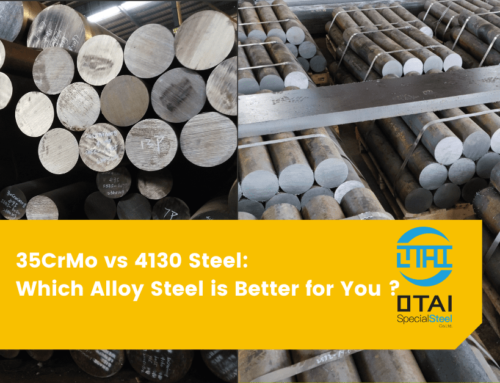

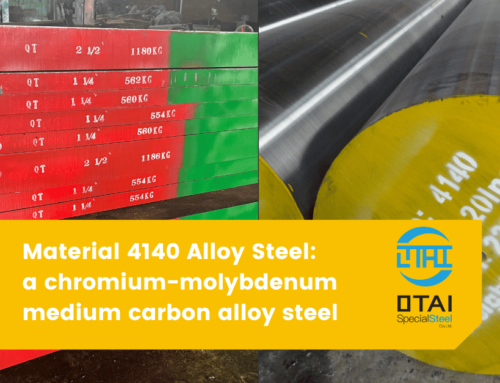
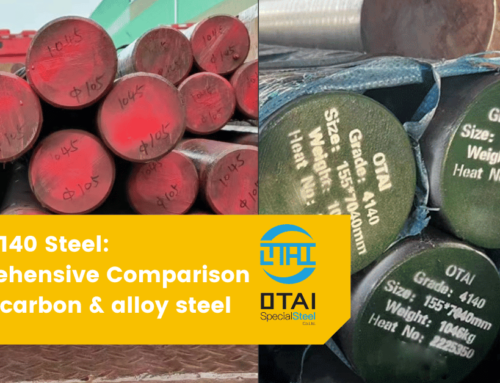
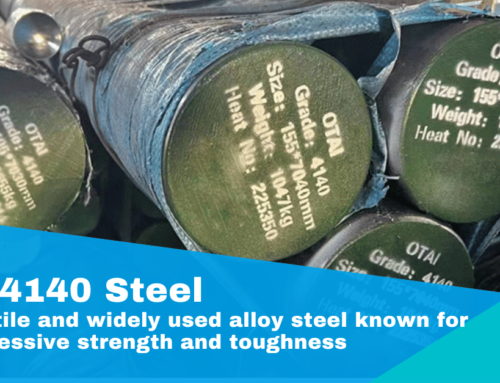
Good knowledge for who people working steel industry
Thank you. Salim.
Very interesting. This is no doubt of interest to gas manufacturers who produce gas blends for cutting and welding purposes. Also to those companies who manufacture tools for cutting and CNC applications.
Just a correction , stainless steel 18-8 is 18 % Cr & 8 % Ni , (not the other way around) , tks for sharing
Yes, Uthup, you are right. I have corrected it. Thanks.